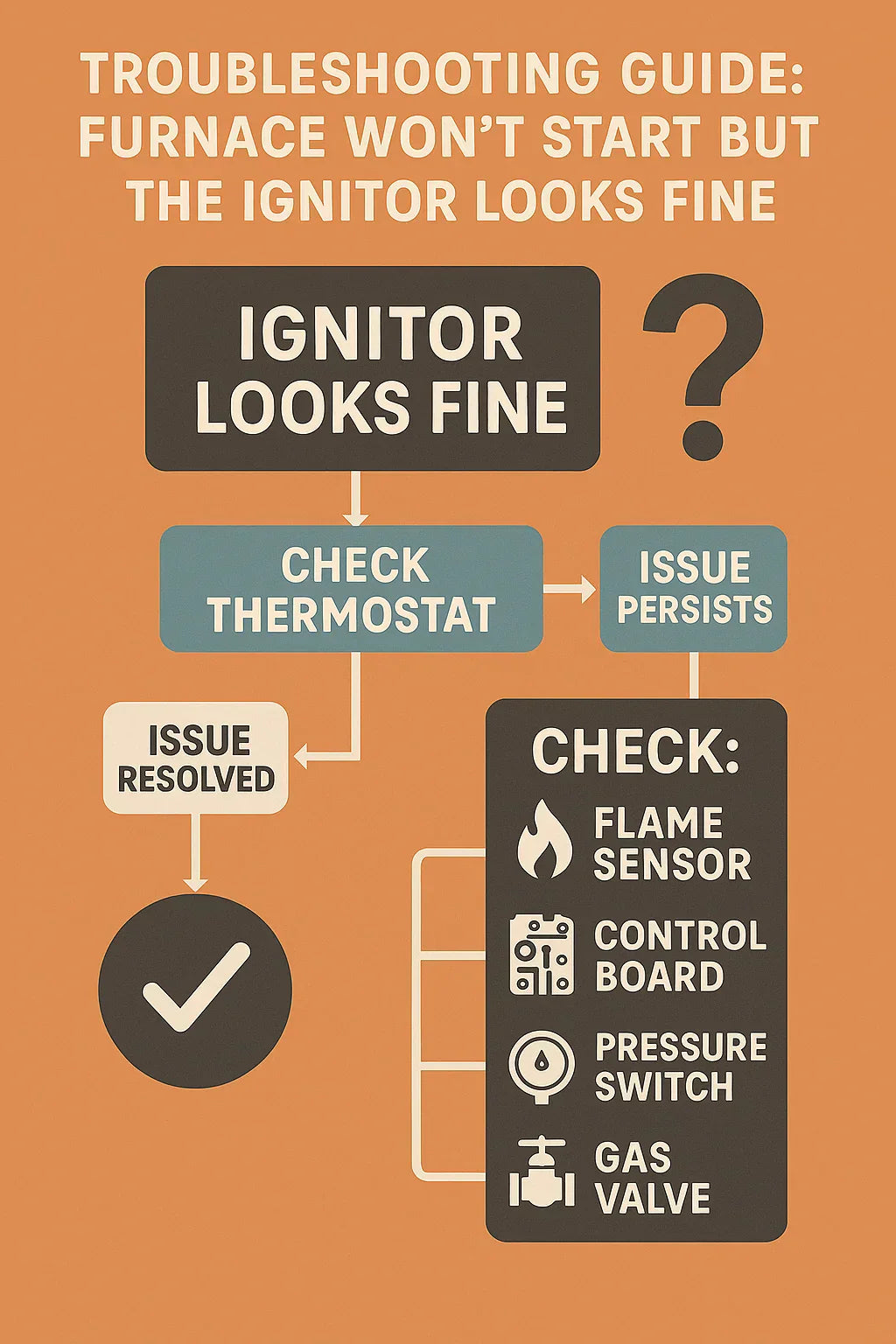Few things are as frustrating as a furnace that refuses to start, especially when you’ve already inspected the hot surface ignitor (HSI) and it looks perfectly fine. Since the ignitor is one of the most common furnace failure points, many homeowners assume it’s always the culprit. But in reality, a furnace ignition cycle involves multiple sensors and controls — any of which can cause a shutdown.
In this guide, we’ll walk you through why your furnace won’t start even if the ignitor looks fine, provide a step-by-step troubleshooting process, and help you know when to DIY versus when to call a professional.
🔥 Why the Ignitor Isn’t Always the Problem
The hot surface ignitor is only one step in your furnace’s ignition sequence. If it looks intact and has no visible cracks or damage, chances are the failure lies elsewhere.
Other components that can cause startup failure include:
-
Flame sensor
-
Control board
-
Pressure switch
-
Gas valve
-
Thermostat or wiring
👉 Understanding the full ignition sequence helps narrow down the issue.
For ignition basics, see Energy.gov – Furnaces and Boilers.
⚠️ Quick Safety Reminder Before Troubleshooting
Before you inspect anything:
-
Turn off furnace power at the breaker.
-
Shut off gas supply if you plan to access burner components.
-
Only perform visual checks and basic cleaning.
-
Leave gas valve or control board repairs to licensed technicians.
Safety first: if you ever smell gas, shut everything off immediately and call a pro.
🔍 Common Causes When the Ignitor Isn’t the Culprit
If the ignitor looks fine, here are the most likely suspects:
🔹 1. Flame Sensor Problems
-
Function: Detects the flame once burners light.
-
Issue: If dirty or faulty, the furnace shuts down immediately after ignition.
-
Fix: Lightly clean with fine emery cloth or replace if damaged.
🔹 2. Faulty Control Board
-
Function: Acts as the “brain” of the furnace, sequencing all operations.
-
Issue: If not sending power to the ignitor or gas valve, ignition fails.
-
Fix: Requires diagnostic testing and replacement if defective.
🔹 3. Pressure Switch Failure
-
Function: Ensures the venting system is clear before allowing ignition.
-
Issue: A stuck, cracked, or clogged switch prevents startup.
-
Fix: Check tubing for blockages or water; replace if faulty.
🔹 4. Gas Valve Problems
-
Function: Releases gas into burners when signaled.
-
Issue: If it doesn’t open, the ignitor glows but no flame appears.
-
Fix: Replacement by a licensed technician.
🔹 5. Thermostat or Wiring Issues
-
Function: Signals the furnace to turn on.
-
Issue: Dead batteries, loose wires, or faulty thermostat can prevent startup.
-
Fix: Replace batteries, inspect connections, or replace thermostat.
For more detail, see ACHR News – Ignition Troubleshooting.
🛠️ Step-by-Step Troubleshooting Guide
Here’s the Savvy homeowner method for systematically checking your furnace:
1. Check Thermostat Settings
-
Make sure it’s in Heat mode.
-
Replace batteries.
-
Set temp 5°F above room temperature.
2. Confirm Power Supply
-
Check the breaker panel (reset if tripped).
-
Ensure furnace switch (near the unit) is on.
3. Inspect Furnace Filter & Airflow
-
Dirty filters restrict airflow and can trigger safety shutdowns.
-
Replace if clogged.
4. Observe Ignition Sequence
-
Restore power and gas, then set thermostat to call for heat.
-
Watch through the sight glass:
-
Draft inducer fan starts
-
Pressure switch activates
-
Ignitor glows
-
Gas valve clicks open
-
Burners ignite
-
👉 If the sequence stops at any point, you’ve found the issue zone.
5. Check Flame Sensor
-
If burners light but quickly shut off, the flame sensor is likely dirty.
-
Clean gently with fine steel wool.
6. Check Pressure Switch Tubing
-
Remove and inspect tubing for cracks, blockages, or moisture.
-
Replace if damaged.
7. Listen for Control Board Activity
-
Clicking sounds indicate relays firing.
-
Watch for LED error codes (consult furnace manual).
👨🔧 When to Call a Professional
DIY checks cover the basics. Call a pro if you encounter:
-
Ignitor glows but gas doesn’t ignite (gas valve issue).
-
Ignitor isn’t receiving voltage (control board issue).
-
Furnace repeatedly locks out with error codes.
-
Any strong smell of gas or electrical burning.
For advanced diagnostics, see HVAC School – Hot Surface Ignitors.
💰 Cost Expectations for Common Repairs in 2025
Here’s what you can expect to pay if DIY doesn’t solve it:
-
Flame sensor cleaning/replacement: $75–$200
-
Pressure switch replacement: $150–$250
-
Control board replacement: $400–$800
-
Gas valve replacement: $300–$750
-
Professional ignitor replacement: $150–$300
👉 Compare this to a full furnace replacement ($3,000–$7,000) — fixing individual parts is almost always worth it.
For averages, see Furnace Repair Costs.
💡 Savvy Homeowner Tips
-
Replace filters regularly to reduce strain on ignition system.
-
Learn to read error codes on the control board — most furnaces blink LED lights to indicate issues.
-
Keep a spare OEM ignitor and flame sensor on hand. They’re inexpensive and easy to swap.
-
Don’t overlook thermostat batteries — they’re a simple fix that many homeowners miss.
For preventive care, see Energy Star – HVAC Maintenance.
✅ Final Takeaway
If your furnace won’t start but the ignitor looks fine, the problem likely lies with another ignition sequence component: flame sensor, control board, pressure switch, gas valve, or thermostat.
-
🔹 Use a step-by-step process to narrow down the culprit.
-
🔹 Perform only safe DIY checks (filters, flame sensor cleaning, thermostat).
-
🔹 Call a pro if the issue involves gas valves or control boards.
-
🔹 Keep spare parts on hand to avoid cold nights and emergency fees.
👉 With this troubleshooting guide, Savvy homeowners can separate simple fixes from pro-level repairs — saving both time and money.
In the next topic we will know more about: Goodman OEM vs. Universal Ignitors: Which Should You Choose?







